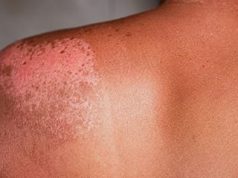The 2022 American Academy of Dermatology Annual Meeting
The annual meeting of the American Academy of Dermatology was held from March 25 to 29 in Boston and attracted more than 12,000 participants from around the world, including clinicians, academicians, allied health professionals, and others interested in dermatology. The conference highlighted recent advances in the diagnosis and management of dermatological conditions.
During one presentation, Esther Freeman, M.D., Ph.D., of Harvard Medical School and Massachusetts General Hospital in Boston, addressed the subject of skin manifestations associated with severe acute respiratory syndrome coronavirus 2 infection and reactions to COVID-19 vaccines.
Freeman discussed a broad range of skin manifestations that have developed as a result of the virus, including more than 30 different types of rashes. The spectrum of skin manifestations is related to each individual’s immune response to the virus, and different skin manifestations correlate with different severity of illness. In terms of vaccine-related dermatologic reactions, Freeman also talked about how a vaccine-related skin reaction component was added to the existing American Academy of Dermatology/International Foundation for Dermatology COVID-19 Dermatology Registry when the vaccines received emergency use authorization. Since that time, more than 1,000 skin reactions to COVID-19 vaccines have been collected. The most common skin conditions that developed after vaccine were injection site reactions, hives, and morbilliform eruptions. In terms of local reactions, there have been local injection site reactions that start a day or two after vaccination, but also, surprisingly, delayed large local reactions, which typically develop seven to eight days after the injection.
“Overall, we can be very reassuring to patients. Data show less than 50 percent who develop skin reactions to the first dose of an mRNA vaccine will go on to have this reaction in future doses. It should be noted that 10 billion doses have [been] given worldwide, so there is a huge amount of safety [data] out there,” Freeman said. “Physicians should be aware of the registry and report any symptoms related to the vaccine or virus itself. This registry is still live for physician reporting. We are particularly interested in understanding ‘long COVID,’ COVID-19 vaccine reactions in general, booster reactions, and breakthrough infections. We are also interested in understanding different types of reactions associated with different variants.”
JiaDe Yu, M.D., of Massachusetts General Hospital in Boston, addressed the need for pediatric patients suffering from itchy rashes to be evaluated for contact allergies.
Yu discussed how pediatric allergic contact dermatitis affects up to 20 percent of children in the United States. However, many children are not referred by their pediatrician or dermatologist for epicutaneous patch testing, which is the gold standard test for the detection of allergic contact dermatitis. As a result, Yu, with the support of the Dermatology Foundation Career Development Award and the Pediatric Dermatology Research Alliance, set up a multicenter prospective pediatric contact dermatitis registry in 2018. The information in the registry is collected periodically, and the results are published on a regular basis to help inform the medical community of the changing prevalence of pediatric contact allergens in the United States. Yu noted that the prevalence of allergic contact dermatitis remains high in children.
“Almost 80 percent of tested children in the registry had positive patch test results. Most common allergens were hydroperoxides of linalool, hydroperoxides of limonene, and nickel,” Yu said. “This study reinforces the important concept that children with difficult-to-treat dermatitis should be evaluated for allergic contact dermatitis with patch testing, because without patch testing, we may be missing an opportunity to treat a large portion of children.”
In another presentation, Julian Trevino, M.D., of Wright State University in Dayton, Ohio, reviewed information on skin conditions caused by exposure to various plants, insects/arthropods, and aquatic organisms.
The information presented was the result of an extensive review of the literature designed to provide attendees with relevant information to assist them in accurately diagnosing and treating such exposures as well as providing information to patients, particularly those engaged in activities where there is an increased likelihood of such hazardous exposure. Trevino noted that awareness of the wide variety of potential indoor and outdoor exposures to various plants, insects/arthropods, and aquatic organisms causing adverse skin reactions can assist clinicians and patients in avoiding such exposures and in properly identifying and managing such exposures when they occur.
“Taking measures to prevent such exposures (in the home, at work, while engaging in leisure activities or while on vacation) can avoid the unpleasant, and in some cases life-threatening, consequences of these exposures,” Trevino said. “Clinicians knowledgeable about [these] exposures can be a valuable resource to colleagues, patients, and community organizations. They can provide accurate information about recognition, treatment, and prevention of such exposures. They can also become engaged in designing better preventative strategies and treatments for these hazardous exposures.”
AAD: Skin Videomicroscopy Biomarker May Help Predict Cancer Relapse
WEDNESDAY, April 6, 2022 (HealthDay News) — For patients who have undergone hematopoietic cell transplantation for hematologic cancer, leukocyte-endothelial interactions visualized directly in skin may help predict prognosis, according to a study published online March 26 in JAMA Dermatology to coincide with the annual meeting of the American Academy of Dermatology, held from March 25 to 29 in Boston.
AAD: Baricitinib Tops Placebo for Hair Regrowth in Alopecia Areata
MONDAY, March 28, 2022 (HealthDay News) — For adults with severe alopecia areata, oral baricitinib is superior to placebo with respect to hair regrowth at 36 weeks, according to a study published online March 26 in the New England Journal of Medicine to coincide with a presentation at the annual meeting of the American Academy of Dermatology, held from March 25 to 29 in Boston.
Copyright © 2022 HealthDay. All rights reserved.








